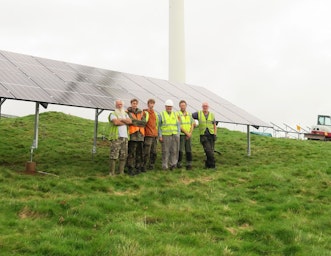
Monitoring your heat pump’s performance
April 3, 2023Home » Monitoring your heat pump’s performance
As heat pumps edge closer to the mainstream, Joel Rawson looks at the importance of monitoring in making this change successful.
The results of monitoring from well-performing heat pumps provides examples of good practice that will help more of us to make a successful switch. It also helps other householders or installers improve systems that are not doing as well as expected. This is important because if heat pumps don’t meet expectations, it can damage consumer confidence in one of the best carbon-saving measures available to us. We don’t need full monitoring for all installations, especially once the market is more developed, but it makes sense for systems put in by ‘early adopters’.
Find out more about heat pumps and other technologies on a CAT short course
Measuring efficiency
The BetaTalk podcast regularly covers heat pumps and how to maximise performance. In an episode last July, CAT graduate Colin Meek, now a partner at energy researchers RB&M, talked about his analysis of monitoring data gathered by Ofgem from hundreds of heat pumps funded through the domestic Renewable Heat Incentive (RHI), a scheme that ran for around eight years until it was replaced with the Boiler Upgrade Scheme in 2022.
Colin’s study found that the average measured efficiency for air source heat pumps in the dataset was 2.71, just under 17% lower than the average predicted efficiency of 3.25 (figures are for the overall ratio of electricity input to heat output across a year). This lower ratio will still give big carbon savings, but householders should be looking for a ratio close to 3 to compete on running costs with the most efficient gas boilers.
Although many heat pumps in the studied group were close to that boundary, they should really have been above it. There are examples of heat pumps achieving an electricity-to-heat ratio close to 4, even in old, hard-to insulate buildings. So, how to address this sub-optimal performance?
Improving performance
Firstly, it’s worth bearing in mind that plenty of gas boilers also underperform. Even though condensing boilers have been mandatory for almost two decades, the way many are set up with high flow temperatures means they’re not actually running in condensing mode very often. This means they’re also running about 15% less efficiently than they would with better design.
Just as tweaks to gas boiler settings can help reduce energy use, there are also remedies for a below-par heat pump. This could be as simple as free or cheap changes to control settings, but sometimes it may need more investment, such as upgrading or adding radiators if these were not properly assessed before the heat pump was fitted.
You can also improve the performance of an existing heat pump by gradually increasing insulation levels in your home over time (as savings or grant funding allows). Once you’ve cut down heat loss, the same radiators can be run at a lower flow temperature, keeping your home just as warm but resulting in an improved ratio of electricity to heat.
How monitoring can help
Many heat pumps work well despite the house not meeting modern insulation standards. There could be a few reasons for this, for example getting a better than usual heat loss assessment beforehand to feed into good sizing and design. But a key factor is often that the householder has good monitoring in place and is using this to fine-tune settings to extract the maximum possible efficiency.
Good monitoring is useful even if you’re not interested in the detail yourself, as it can be fed into a monitoring programme. Gathering data from large numbers of heat pumps in many different house types enables the comparison of factors such as heat loss, emitter sizing, flow rates, buffer tanks, and more. All of this should be fed into improving design standards and giving training and professional development to new and current installers.
For example, the analysis of monitoring data from real-world systems can help with issues like the debate around buffer tanks. Some systems come with them as standard, but several heat pump experts argue against using a buffer tank if possible – saying that if you instead specify enough volume in the heating system (including the radiators) you’ll get a more efficient heat pump.

Building public confidence
Monitoring is one of the recommendations in the report ‘Accelerating the transition to heat pumps’, published last September by the Energy Futures Lab at Imperial College. This also looks at many other important measures – such as better methods for assessing heat loss, to improve the sizing of emitters and heat pumps.
As the study highlights, there is some controversy at the moment in the media about when heat pumps will and won’t work – and this is leading to a lack of confidence in many householders, given the investment and commitment needed to make the switch from a gas boiler.
To address this and other barriers to a rapid decarbonisation of heating, the report recommends improving the measurement of building performance (rather than using estimations), monitoring the performance of installed heat pumps, and sharing the results of this through a database of case studies.
Metering equipment
The previous RHI grant scheme required heat metering in some cases and offered financial support to people putting in an optional metering monitoring service package (MMSP). As well as giving more information to people about how their heat pump is performing, MMSPs allow for analysis on a much larger scale.
A heat meter needs a few sensors to measure the temperature being delivered, the temperature returning to the heat pump, the flow rate, and the temperature inside and outside the house. The data about heat flows and electricity use can be downloaded, shared online, and used to make graphs and other summaries to help you or others understand and improve how the system is working.
Measuring the (relatively) low temperatures being delivered by a heat pump can be challenging, and the sort of equipment up to the job could well cost several hundred pounds.
Under the new Boiler Upgrade Scheme grant, the monitoring of heat output is optional (not required or supported). Therefore, if you have or are planning to install a heat pump, you could enquire about MMSP or equivalent options if you want to either monitor the system yourself or contribute the data for others to use.
Some heat pump systems come with more detailed monitoring as standard – and one of the useful results of independent monitoring will be to evaluate how effective this built-in monitoring actually is for different brands. If you’re happy with the technical detail involved, you could set up your own monitoring system. The ‘Heat Pump Monitoring’ section of the Open Energy Monitor website has details of different monitoring setups, what sort of data can be obtained, and lots of links giving more detail – for example, a list of suitable heat meters.
Further information on heat pump monitoring
- BetaTalk renewable energy and lowcarbon heating podcast regularly covers heat pump systems and monitoring – betatalk.buzzsprout.com
- Heat pump expert and CAT guest lecturer John Cantor has an easily searchable website with a wealth of useful information – heatpumps.co.uk
- For those who want to set up their own monitoring, Open Energy Monitor has a section dedicated to heat pumps – openenergymonitor.org
- Data from several heat pump systems is available at heatpumpmonitor.org, which uses Open Energy Monitor equipment. It shows the measured efficiency alongside information about the heat pump being used, the age and type of building, insulation levels, and so on.
- Trystan Lea of Open Energy Monitor gives a detailed breakdown of his own monitoring setup on his website – https://trystanlea.org.uk/monitoring
- If you’d like to see a heat pump in action and talk to people who have them installed in their homes, you can register for Nesta’s ‘Visit a Heat Pump’ scheme (currently at pilot stage) – visitaheatpump.com
About the author
Joel Rawson is CAT’s Information Officer, providing free and impartial advice on a wide range of topics related to sustainability. He first came to CAT to volunteer in 2001, and graduated with a CAT Postgraduate Diploma in 2013.
CAT’s free information service
Visit our Free Information webpages for information and advice on a wide range of areas related to homes, buildings, energy and more.
Related Pages
Related news



CAT Conversations: Sandy Stevens, CAT graduate
17th April 2025
More solar energy for CAT
4th April 2025EMAIL SIGN UP
Keep up to date with all the latest activities, events and online resources by signing up to our emails and following us on social media. And if you'd like to get involved and support our work, we'd love to welcome you as a CAT member.
